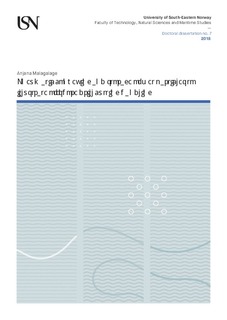| dc.contributor.author | Malagalage, Anjana | |
| dc.date.accessioned | 2018-06-18T12:32:03Z | |
| dc.date.available | 2018-06-18T12:32:03Z | |
| dc.date.issued | 2018-06-29 | |
| dc.identifier.isbn | 978-82-7206-482-1 | |
| dc.identifier.issn | 2535-5252 | |
| dc.identifier.uri | http://hdl.handle.net/11250/2501915 | |
| dc.description.abstract | In this thesis, the pneumatic conveying and storage characteristics of particles mixed with a drilling fluid are studied based on the pilot scale experiments. The objective of this research is to investigate the impact of the presence of a drilling fluid towards the pneumatic conveying and storage properties of a bulk solid, which can be utilized in offshore drill cuttings handling.
Fluidization tests were conducted for sand samples with different particle size distributions and for a treated drill cuttings sample. Tests were conducted for both dry and wet (mixed with a drilling fluid) conditions. For this study two drilling fluids were considered namely, EDC 95/11 (a base oil) and a premix based on EDC 95/11. The comparison of the results shows that the minimum fluidization velocity of a particular dry particle system is significantly increased when a small amount of drilling fluid (1.5% by weight) is introduced to particle mixture. However, there was no significant deviation of the fluidization behaviour when the drilling fluid concentration was increased from 1.5% up to 6.3% but when it was further increased up to 10 %, the minimum fluidization velocity started to increase. The phenomenon was observed in both sand and treated drill cuttings sample with both drilling fluids.
The same sand mixtures were used in the pilot scale pneumatic conveying tests in dilute state both under dry and wet (mixed with the premix) conditions. Horizontal pneumatic conveying pressure drop displayed a similar behaviours as the minimum fluidization velocity with the drilling fluid concentration. That is, the pressure drop corresponding to the sand-drilling fluid mixture at concentration of 1.5% was significantly low compared to the pressure drop of the same dry sand mixture. It was also observed that the deviation of the minimum fluidization velocity of a wet sand mixture with respect to its dry condition and the the deviation of the horizontal pneumatic pressure drop of the same wet sand mixture with respect to its dry condition are closely correlated. An empirical model was developed to predict the pressure drop of horizontal pneumatic conveying under dilute conditions. The model can successfully predict the pressure drop of the same dry material with different size distributions. It was shown that by incorporating the reduction of the minimum fluidization velocity which was obtained by the fluidization tests, the proposed model can predict the horizontal pneumatic conveying pressure drop of sand-drilling fluid mixtures approximately.
Bulk solid flow properties of a sand-drilling fluid mixture with different drilling fluid concentrations were analysed by using Jenike shear tester. The study shows that the flowability of the bulk solid depends on the fluid concentration, type of the fluid and the time period which the bulk solid is subjected under stress. With increasing fluid concentration, the flowability of the bulk solid reduce and reaches a minimum and beyond that the flowability improves as the bulk solid starts to behave as a slurry. Sand sample mixed with water displayed a lower flowability compared to the sand-drilling fluid mixtures. A sand-soap mixtures displayed a similar behaviour to the sand-drilling fluids approximately. It was also observed that the 7 days time consolidation has reduced the flowability of all the sand samples with different fluid types and concentrations. | nb_NO |
| dc.language.iso | eng | nb_NO |
| dc.publisher | University of South-Eastern Norway | nb_NO |
| dc.relation.ispartofseries | Doctoral dissertations at the University of South-Eastern Norway;7 | |
| dc.relation.haspart | Paper A: Malagalage, A., Ratnayake, C. & Saasen, A.: Powder conveying principles for efficient handling of offshore drill cuttings. The 8th International Conference for Conveying and Handling of Particulate Solids. Tel-Aviv, Israel, 3-7 May 2015. | nb_NO |
| dc.relation.haspart | Paper B: Malagalage, A., Ariyarathne, W.K.H., Ratnayake, C. & Melaaen, M.C.: Experiments and simulations for horizontal pneumatic transport of dry drill cuttings. Chemical Engineering & Technologyers in Energy Research 41, (2018). Submitted version. The published version is available at https://doi.org/10.1002/ceat.201700553 | nb_NO |
| dc.rights | Navngivelse-Ikkekommersiell-DelPåSammeVilkår 4.0 Internasjonal | * |
| dc.rights.uri | http://creativecommons.org/licenses/by-nc-sa/4.0/deed.no | * |
| dc.title | Pneumatic conveying and storage of wet particles to illustrate offshore drill cutting handling | nb_NO |
| dc.type | Doctoral thesis | nb_NO |
| dc.description.version | publishedVersion | nb_NO |
| dc.rights.holder | © 2018 Anjana Malagalage, except otherwise stated | nb_NO |
| dc.subject.nsi | VDP::Technology: 500::Chemical engineering: 560 | nb_NO |

